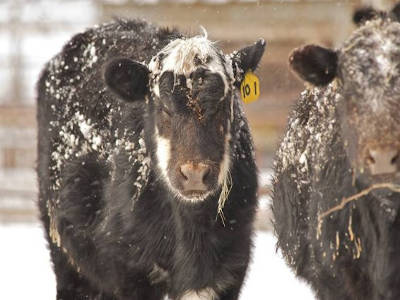Blasts of cold winter weather interspersed with almost spring-like temperatures this time of year can be particularly stressful to cattle health and conditioning. The online Oklahoma Mesonet Cattle Comfort Advisor can help producers manage those challenges.
“Frequent shifts in the weather can lead to dysfunction of an animal’s immune system and can be devastating to a calf’s ability to overcome infections and other health challenges,” said Dr. Rosslyn Biggs, Oklahoma State University Extension veterinarian and director of continuing education for the university’s College of Veterinary Medicine.
Bad weather can have additional impacts on livestock by changing conditions in the field – reduced access to feed and increased risk of injury, for example. Good livestock managers who prioritize livestock well-being are rewarded with healthy weight gain, Biggs said.
To stay on top of changing conditions, the Cattle Comfort Advisor provides minimum-to-maximum weather data on statewide maps for the two most recent days, the current-day’s forecast and an outlook for the next two.
For a more detailed view of cattle comfort at a local ranch, time series graphs are available. A map of the past 10 days with a forecast provides hourly cattle comfort information based on Mesonet data and the National Weather Service North American Mesoscale Forecast. A graph of the past 45 days also is available.
The ability to forecast environmental effects at such scales can be paramount, especially at the boundaries of weather phenomenon. In late November, for example, a foot of snow shut down Harper, Ellis and Woodward counties, as well as parts of Beaver County. However, just a little farther east to Garfield County, local OSU Extension Agricultural Educator Rick Nelson reported only much-needed rain. Westward through the Oklahoma Panhandle, Texas and Cimarron counties got a bit of snow but a lot of wind under overcast skies.
“It was dark. The wind was about 40 miles per hour. Ranchers were struggling to put up wind breaks and get out hay for livestock. The snowfall was dry and blowing every which way, but our roads were open, which they were not a few counties to the east,” said Justin Wagner, Cimarron County Extension agricultural educator. “It all came in fast, and then departed just as fast, though cooler temperatures held on for a while.”

Oklahoma has more than 5 million head of cattle that may need help getting through winter in good health.
Checking the Cattle Comfort Advisor regularly can help a producer assess and prioritize what needs to be done before inclement weather hits, said Dr. Barry Whitworth, OSU Extension veterinarian and food animal quality and health specialist.
“Cattle producers need to be particularly vigilant to ensure water sources do not freeze,” he said. “Also, lameness can occur if cattle are required to walk on rough ground that has frozen. Many infectious agents that cause respiratory or gastrointestinal disease can proliferate in winter conditions as cattle congregate in groups.”
A general rule based on several research studies is that cattle energy requirements increase by 1% for each degree drop in temperature below freezing. For example, a producer using the Cattle Comfort Advisor might determine the effective temperature – adjusted for wind chill – to be 17 degrees. That means the energy needs of cattle with dry winter coats in that area would be about 15% greater than in more moderate conditions. The energy requirement would be about 40% greater if the animal’s hair coat is wet.
Whitworth and Biggs said wind chill must always be included when calculating the severity of conditions. For example, a 15 mph wind at 20 degrees has the same effect as a temperature of 6 degrees with no wind. Fortunately, the Cattle Comfort Advisor makes the task quick and easy.